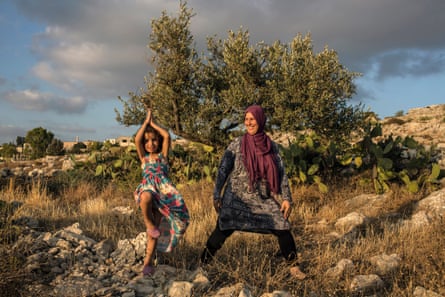“We thought it was a Buddhist practice of just sitting still and saying ‘om’,” said one woman, at the start of the first-ever yoga teacher training in Palestine’s West Bank.
A lack of yoga teachers, and a social stigma from the confused belief that the practice had something to do with a foreign religion, meant that until recently not many Palestinians had had exposure to yoga or meditation. But in 2010 Farashe opened, a volunteer-based nonprofit community yoga centre in Ramallah that focuses on outreach.
In 2012 and 2013, Farashe was boosted when Washington DC-based nonprofit Anahata International ran teacher training for Palestinian women to take the self-care techniques into their communities on the West Bank. With training from Farashe and others, over the last three years, about 80 men and women have become yoga teachers.
Today, yoga-based practices are integrated into community centres and gyms, not only among the elite of cosmopolitan Ramallah, but also in the small villages. It’s used in health clinics in crowded refugee camps, and in classes at small private studios led by new teachers trained by international volunteers.
Palestinians living under the Israeli occupation face stresses that affect their psychological and physical health. The merging of the 4,000-year-old tradition of yoga with the modern science of stress relief is giving West Bank residents the tools to manage their day-to-day wellbeing.
“It’s grown in popularity because of social media,” says Nahed Bandak, who has been teaching yoga for 10 years and has seen classes increase from a handful of students to full capacity in recent years. “People are reading and seeking alternatives to ease what they’re suffering. They want comfort. When they read and see reviews, they want to try yoga too.”
The growing popularity of yoga was not without resistance in more conservative areas, with some seeing the practice as being part of Buddhism or Hinduism. But over and over, new teachers who are practicing Muslims came to the conclusion that yoga postures helped them with their own prayers. During training they spoke about the similarity between the bowing and kneeling in both practices and found themselves more supple for the five-times daily prayers. Many said they also benefited from the focus and stillness of the meditative aspect of yoga, connecting more with the intention and sentiment of their prayers.

Basma Abu Sway, a board member of Farashe and former general director of the family and children department in the Palestinian ministry of social affairs, started teaching yoga in a village north of Jerusalem through a UN Relief and Works Agency (UNRWA) programme at the beginning of the year. A report by UNRWA cites chronic lifestyle illnesses among the population as their main health concern, exacerbated by extreme restrictions in movement for Palestinians. “Yoga that can help us with these circumstances,” Abu Sway says. “It helps people reach inner balance. It helps ease these pressures. Even to just have one hour for ourselves to step away from the negativity, listen to our hearts, our minds, and rest, this hour will help so much.”
Although the majority of those attending are women, men come too. “For a lot of the men, there are many things in their daily lives that they cannot control,” says Ali, who taught the first teacher training for men at the beginning of 2015. “They can’t even go from one place to another on the road without facing hurdles and humiliations. This creates anger and frustration and they are not always equipped to deal with it.”
This also translates into tensions in the body, Ali says. “The diligent practice of the yoga asanas allows them to take that restful peace into their bodies and from there, understand it in their minds.”
The Palestinian yoga pioneers see the next part of the journey as creating a sustainable future for the practice by equipping local Palestinians to give training and workshops without the help of international volunteers. “We need to be able to help ourselves,” Abu Sway says. Farashe is working on making yoga accessible in the Arabic language, developing written and video material and seeking funding to open more Farashe centres in Palestine.
But Abu Sway cautions against giving yoga a bigger role than it deserves. “It’s not a solution for ending the occupation,” she says. “It doesn’t solve our problems. It’s important to see it as for the self first, not for society. But at least those individuals can cope with life’s problems and the environment.”
It can also encourage an optimistic attitude in the mires of a decades-long political stalemate. “There’s always a solution,” Bandak says. “We need to have hope, this is how we survive.”
Join our community of development professionals and humanitarians. Follow@GuardianGDP on Twitter.

Comments (…)
Sign in or create your Guardian account to join the discussion